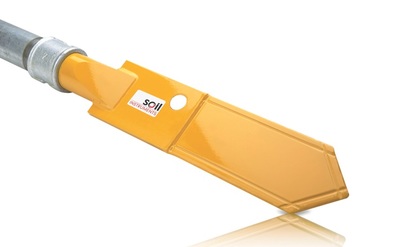The Vibrating Wire Push-In Pressure Cell is normally installed in vertical boreholes and measures total horizontal stresses. They are often installed in stiff clay behind and in front of retaining walls, in soft puddle clay cores of old embankment dams and in glacial till adjacent to sea cliffs.
The Vibrating Wire Push-In Pressure Cell measures total earth pressures in all soil types. The cell is spade-shaped and pointed at one end. A piezometer within the unit allows the measurement of pore water pressure and therefore the derivation of effective pressure.
The cell is formed from two sheets of steel welded around the periphery, with the narrow gap between the plates being filled with oil. A Vibrating Wire pressure transducer is connected by a short steel tube, forming a sealed hydraulic system.
A porous filter disc is incorporated in the cell and is connected to a second Vibrating Wire transducer, together forming an integral piezometer. The two Vibrating Wire transducers are mounted in tandem behind the spade-shaped cell and protected within the installing pipe.
Product Features
- Uses proven Vibrating Wire technology
- Designed to be pushed into all soil types
- Recoverable push-in casing
- Additional, integral pore pressure sensor allows derivation of effective pressure
- Measures total earth pressures in all soil types
- Fast response to low volume pressure changes
- Suitable for manual or remote monitoring
- Fitted with thermistor for temperature monitoring
- Strong, screened and flexible connecting cables
Product Benefits
- Over 30 years of expertise in the design and manufacture of Vibrating Wire instrument technology
- Push-in design facilitates perfect contact with the soil
- Accurate, repeatable readings over long cable lengths
- Long working life, longterm stability and reliability
- Over-voltage surge arrestor protects against electrical damage
- Design prevents case stresses from affecting readings
Operation
A borehole is formed to a depth just short of the installation level.
The Push-In Pressure Cell is lowered to the base of the borehole via the push-in casing. Once at the base, the orientation of the cell is checked before pushing it to its final elevation below the base of the borehole. The temporary push-in casings are then removed leaving the cell in situ.
After the removal of the push-in casings, the borehole is grouted. The sensor cables connect the transducers to either a terminal unit or data logger.
Application
The Vibrating Wire Push-in Pressure Cell monitors changes in earth pressure associated with the construction of excavations, embankments and dams. The instrument is capable of providing total pressure, earth pressure and ground water pressure readings. Vibrating Wire Pressure cells are often installed in stiff clay behind and in front of retaining walls, in soft puddle clay cores of old embankment dams and in glacial till adjacent to sea cliffs.
Typical applications include:
- Measuring the total horizontal stresses in vertical boreholes
- Measuring horizontal and vertical stresses in horizontally drilled boreholes, such as around tunnels and cliff faces
- As a site investigation tool to measure the in situ stresses in the ground prior to any disturbance or construction
- Measuring total pressure within tailings dams
- Measuring foundation bearing pressures.
Geomotion offer installation and monitoring services to support this system. For more information please email info@geomotion.com.au or contact any of our locations.
